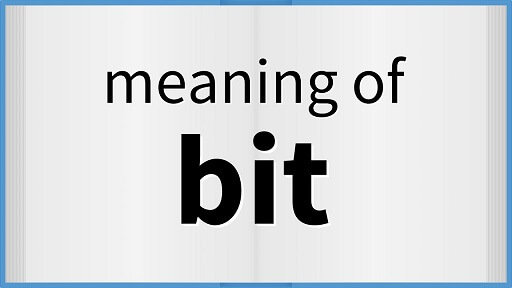What is Bit?
A bit is a basic unit of information or is the smallest unit of data in the computer and digital communications, which stands for binary digit. Either 1 or a 0 (off or on, low or high, false or true) is used to represent each bit. A byte is made up of eight bits, if you had three bytes (word), it would be 24 bits (3 x 8=24), and 12 bytes will be 96 bits (12 x 8=96).

Usually, computers offer instructions that can manipulate and test bits, but they are designed to store collected data in an eight-bit piece known as bytes. The four bits (half a byte) are known as a nibble. For an eight-bit unit, rather than byte the term octet is used in some computers. The octets or four eight-bit bytes form a 32-bit word on many computers. In such systems, the length of instructions is sometimes explicated as half-word (16 bits in length) or full-word (32 bits in length).
There are many other forms that can be used to represent bits; those various forms are electrical voltage, through current pulses, or the state of an electronic flip-flop circuit. Most of the logic devices represent the binary digit 0 as a logical false value and 1 for true. Through voltage levels, the difference between them is stated. Generally, the bit is how the information is transmitted and expressed in computing.
Also, with the help of bits, the computer’s processing power may be measured in terms of how many bits can be processed by a computer at one time. The number of bits is used in graphics; each dot reflects the color, quality, and clarity of the picture. Furthermore, the number of bits per second communicated over a network. Byte, which is correspondent to one alphanumeric character and comprises eight consecutives; also, it is the most common storage unit in a computer. The components of computer storage, like files, disks, and databases, contain storage capacities expressed in bytes instead of bits.
Bits in a computer processor
The processors of beginning computers, such as 8088 and 80286 were had the capability to function with 16-bit binary numbers as they were 16-bit processors. Later, to work with 32-bit binary numbers, the 32-bit processor was introduced. Nowadays, computers come with 64-bit that are capable of working with 64-bit binary numbers.
History of the bit
By discrete bits in the punched cards, the use of encoding data invented by Jean-Baptiste Falcon and Basile Bouchon in 1732, Joseph Marie Jacquard developed it in 1804. Later, it was adopted by Charles Babbage, Semyon Korsakov, Hermann Hollerith, and initially computer manufacturers such as IBM. The perforated paper tape was another variation of that concept. The card or tape (medium) theoretically carried the collection of hole positions in all those systems; all positions could be able to be punched through or not, therefore carrying one bit of information. In 1844, the use of encoding of text by bits was performed in Morse code and in 1870, was also used in initially digital communications machines like stock ticker and teletypes machines.
In 1928, a logarithmic measure of information was suggested by Ralph Hartley and described how to use it. In 1948, the “bit” word was used by Claude E. Shannon for the first time in his seminal paper named “A Mathematical Theory of Communication”. He credited its basic to John W. Tukey, who was the writer of the Bell Labs memo that was written on 9 January 1947. He contracted the binary information digit to a bit in Bell Labs memo. In 1936, to be stored on the punched cards, the “bits of information” was written by Vannevar Bush. At that time, mechanical computers used this bit of information.
Bits in color
In the colors, bit has an important role as it helps to calculate color depth by 2 to the power of the bit color. For example, an 8-bit color describes 256 colors that would be 2^8.
Bit-based computing
Instead of manipulating data interpreted as combined bits, few computer instructions (bitwise computer processor instructions) work on the level of manipulating bits. For setting or copying the bits that corresponded to a given rectangular area on the screen, bit block transfer instructions were offered by some computers when bitmapped computers were gaining popularity on the market in the 1980s.
When a bit within a group of bits like a byte or word is referred to in most computers and programming languages, so, within the byte or word, it is defined with the help of a number from 0 upwards corresponding to its position. However, on the basis of the context, 0 can refer to the most or least significant bit.
A bit is an acronym, can we write it in all uppercase?
Like most acronyms, a bit can be written in both form in all lowercase or uppercase, although it is an acronym. It depends on you what style you choose to write in lowercase or uppercase, but make sure to remain consistent.
